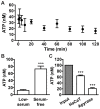Ecto-nucleoside triphosphate diphosphohydrolase 2 modulates local ATP-induced calcium signaling in human HaCaT keratinocytes
- PMID: 23536768
- PMCID: PMC3594229
- DOI: 10.1371/journal.pone.0057666
Ecto-nucleoside triphosphate diphosphohydrolase 2 modulates local ATP-induced calcium signaling in human HaCaT keratinocytes
Abstract
Keratinocytes are the major building blocks of the human epidermis. In many physiological and pathophysiological conditions, keratinocytes release adenosine triphosphate (ATP) as an autocrine/paracrine mediator that regulates cell proliferation, differentiation, and migration. ATP receptors have been identified in various epidermal cell types; therefore, extracellular ATP homeostasis likely determines its long-term, trophic effects on skin health. We investigated the possibility that human keratinocytes express surface-located enzymes that modulate ATP concentration, as well as the corresponding receptor activation, in the pericellular microenvironment. We observed that the human keratinocyte cell line HaCaT released ATP and hydrolyzed extracellular ATP. Interestingly, ATP hydrolysis resulted in adenosine diphosphate (ADP) accumulation in the extracellular space. Pharmacological inhibition by ARL 67156 or gene silencing of the endogenous ecto-nucleoside triphosphate diphosphohydrolase (NTPDase) isoform 2 resulted in a 25% reduction in both ATP hydrolysis and ADP formation. Using intracellular calcium as a reporter, we found that although NTPDase2 hydrolyzed ATP and generated sustainable ADP levels, only ATP contributed to increased intracellular calcium via P2Y2 receptor activation. Furthermore, knocking down NTPDase2 potentiated the nanomolar ATP-induced intracellular calcium increase, suggesting that NTPDase2 globally attenuates nucleotide concentration in the pericellular microenvironment as well as locally shields receptors in the vicinity from being activated by extracellular ATP. Our findings reveal an important role of human keratinocyte NTPDase2 in modulating nucleotide signaling in the extracellular milieu of human epidermis.
Conflict of interest statement
Figures





Similar articles
-
Activation-dependent trafficking of NTPDase2 in Chinese hamster ovary cells.Int J Biochem Cell Biol. 2007;39(4):810-7. doi: 10.1016/j.biocel.2007.01.003. Epub 2007 Jan 20. Int J Biochem Cell Biol. 2007. PMID: 17307380
-
ATP release, generation and hydrolysis in exocrine pancreatic duct cells.Purinergic Signal. 2015 Dec;11(4):533-50. doi: 10.1007/s11302-015-9472-5. Epub 2015 Oct 2. Purinergic Signal. 2015. PMID: 26431833 Free PMC article.
-
Extracellular ATP activates hyaluronan synthase 2 (HAS2) in epidermal keratinocytes via P2Y2, Ca2+ signaling, and MAPK pathways.Biochem J. 2018 May 24;475(10):1755-1772. doi: 10.1042/BCJ20180054. Biochem J. 2018. PMID: 29626161
-
Nucleotide- and nucleoside-converting ectoenzymes: Important modulators of purinergic signalling cascade.Biochim Biophys Acta. 2008 May;1783(5):673-94. doi: 10.1016/j.bbamcr.2008.01.024. Epub 2008 Feb 12. Biochim Biophys Acta. 2008. PMID: 18302942 Review.
-
Purinergic signaling in the modulation of redox biology.Redox Biol. 2021 Nov;47:102137. doi: 10.1016/j.redox.2021.102137. Epub 2021 Sep 22. Redox Biol. 2021. PMID: 34563872 Free PMC article. Review.
Cited by
-
Biotin Is Required for the Zinc Homeostasis in the Skin.Nutrients. 2019 Apr 24;11(4):919. doi: 10.3390/nu11040919. Nutrients. 2019. PMID: 31022908 Free PMC article.
-
Zinc and Skin Disorders.Nutrients. 2018 Feb 11;10(2):199. doi: 10.3390/nu10020199. Nutrients. 2018. PMID: 29439479 Free PMC article. Review.
-
UTP increases wound healing in the self assembled skin substitute (SASS).J Cell Commun Signal. 2023 Sep;17(3):827-844. doi: 10.1007/s12079-023-00725-2. Epub 2023 Feb 1. J Cell Commun Signal. 2023. PMID: 36723784 Free PMC article.
-
Double-modified, thio and methylene ATP analogue facilitates wound healing in vitro and in vivo.Sci Rep. 2024 Jun 7;14(1):13148. doi: 10.1038/s41598-024-63759-5. Sci Rep. 2024. PMID: 38849425 Free PMC article.
-
Human Keratinocytes Respond to Extracellular UTP by Induction of Hyaluronan Synthase 2 Expression and Increased Hyaluronan Synthesis.J Biol Chem. 2017 Mar 24;292(12):4861-4872. doi: 10.1074/jbc.M116.760322. Epub 2017 Feb 10. J Biol Chem. 2017. PMID: 28188289 Free PMC article.
References
-
- Baroni A, Buommino E, De Gregorio V, Ruocco E, Ruocco V, et al. (2012) Structure and function of the epidermis related to barrier properties. Clinics in Dermatology 30: 257–262. - PubMed
-
- Proksch E, Brandner JM, Jensen JM (2008) The skin: an indispensable barrier. Experimental Dermatology 17: 1063–1072. - PubMed
-
- Wickett RR, Visscher MO (2006) Structure and function of the epidermal barrier. American Journal of Infection Control 34: S98–S110.
-
- Boulais N, Misery L (2008) The epidermis: a sensory tissue. European Journal of Dermatology 18: 119–127. - PubMed
-
- Roosterman D, Goerge T, Schneider SW, Bunnett NW, Steinhoff M (2006) Neuronal control of skin function: the skin as a neuroimmunoendocrine organ. Physiol Rev 86: 1309–1379. - PubMed
Publication types
MeSH terms
Substances
LinkOut - more resources
Full Text Sources
Other Literature Sources

